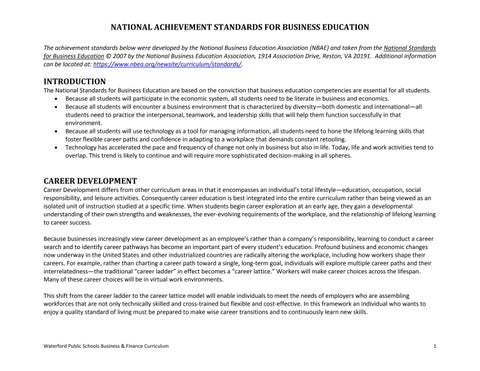NATIONAL ACHIEVEMENT STANDARDS FOR BUSINESS EDUCATION The achievement standards below were developed by the National Business Education Association (NBAE) and taken from the National Standards for Business Education © 2007 by the National Business Education Association, 1914 Association Drive, Reston, VA 20191. Additional information can be located at: https://www.nbea.org/newsite/curriculum/standards/.
INTRODUCTION The National Standards for Business Education are based on the conviction that business education competencies are essential for all students. Because all students will participate in the economic system, all students need to be literate in business and economics. Because all students will encounter a business environment that is characterized by diversity—both domestic and international—all students need to practice the interpersonal, teamwork, and leadership skills that will help them function successfully in that environment. Because all students will use technology as a tool for managing information, all students need to hone the lifelong learning skills that foster flexible career paths and confidence in adapting to a workplace that demands constant retooling. Technology has accelerated the pace and frequency of change not only in business but also in life. Today, life and work activities tend to overlap. This trend is likely to continue and will require more sophisticated decision‐making in all spheres.
CAREER DEVELOPMENT Career Development differs from other curriculum areas in that it encompasses an individual’s total lifestyle—education, occupation, social responsibility, and leisure activities. Consequently career education is best integrated into the entire curriculum rather than being viewed as an isolated unit of instruction studied at a specific time. When students begin career exploration at an early age, they gain a developmental understanding of their own strengths and weaknesses, the ever‐evolving requirements of the workplace, and the relationship of lifelong learning to career success. Because businesses increasingly view career development as an employee’s rather than a company’s responsibility, learning to conduct a career search and to identify career pathways has become an important part of every student’s education. Profound business and economic changes now underway in the United States and other industrialized countries are radically altering the workplace, including how workers shape their careers. For example, rather than charting a career path toward a single, long‐term goal, individuals will explore multiple career paths and their interrelatedness—the traditional “career ladder” in effect becomes a “career lattice.” Workers will make career choices across the lifespan. Many of these career choices will be in virtual work environments. This shift from the career ladder to the career lattice model will enable individuals to meet the needs of employers who are assembling workforces that are not only technically skilled and cross‐trained but flexible and cost‐effective. In this framework an individual who wants to enjoy a quality standard of living must be prepared to make wise career transitions and to continuously learn new skills.
Waterford Public Schools Business & Finance Curriculum
1

